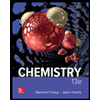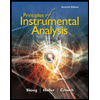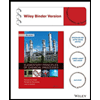
ORGANIC CHEMISTRY-STUD.SOLNS.MAN+SG(LL)
4th Edition
ISBN: 9781119659587
Author: Klein
Publisher: WILEY
expand_more
expand_more
format_list_bulleted
Question
Chapter 21.1, Problem 2CC
Interpretation Introduction
Interpretation:
To draw a mechanism for acid catalyzed conversion of 1-cyclohexenol to cyclohexanone.
Concept introduction:
Keto-enol isomerization is possible when a keto group present in the compound has a movable hydrogen atom in the next carbon attached to the carbonyl group. This occurs generally in almost all keto compounds where a chemical equilibria is present between the keto and enol form of the compound. Conversion of keto to its enol form is known as keto-enol tautomerisation. This conversion occurs in presence of acid or base.
Expert Solution & Answer
Want to see the full answer?
Check out a sample textbook solution
Students have asked these similar questions
A chemist fills a reaction vessel with 0.281 g silver chromate (Ag₂CrO4) solid, 0.710 M silver (Ag*) aqueous solution, and 0.985 M chromate (CrO2-)
aqueous solution at a temperature of 25.0°C.
Under these conditions, calculate the reaction free energy AG for the following chemical reaction:
Ag2CrO4(s) 2Ag(aq) + CrO4(aq)
Use the thermodynamic information in the ALEKS Data tab. Round your answer to the nearest kilojoule.
4
☐ kJ
x
Draw the structure corresponding to each IUPAC name.
Part 1 of 2
A skeletal structure corresponding to the IUPAC name 3-ethylhexane.
Click and drag to start drawing a
structure.
Using any data you can find in the ALEKS Data resource, calculate the equilibrium constant K at 25.0 °C for the following reaction.
TiC₁₁(g) + 2H₂O(g) → TiO2 (s) + 4HCl (g)
4
Round your answer to 2 significant digits.
K = ☐
x10
D
Х
Chapter 21 Solutions
ORGANIC CHEMISTRY-STUD.SOLNS.MAN+SG(LL)
Ch. 21.1 - Prob. 1CCCh. 21.1 - Prob. 2CCCh. 21.1 - Prob. 3CCCh. 21.1 - Prob. 1LTSCh. 21.1 - Prob. 4PTSCh. 21.1 - Prob. 5ATSCh. 21.1 - Prob. 6CCCh. 21.1 - Prob. 7CCCh. 21.2 - Prob. 8CCCh. 21.2 - Prob. 9CC
Ch. 21.2 - Prob. 10CCCh. 21.2 - Prob. 11CCCh. 21.2 - Prob. 12CCCh. 21.2 - Prob. 13CCCh. 21.3 - Prob. 2LTSCh. 21.3 - Prob. 14PTSCh. 21.3 - Prob. 15PTSCh. 21.3 - Prob. 3LTSCh. 21.3 - Prob. 4LTSCh. 21.3 - Prob. 19PTSCh. 21.3 - Prob. 21CCCh. 21.3 - Prob. 22CCCh. 21.3 - Prob. 23CCCh. 21.4 - Prob. 24CCCh. 21.4 - Prob. 25CCCh. 21.4 - Prob. 26CCCh. 21.4 - Prob. 27CCCh. 21.4 - Prob. 28CCCh. 21.5 - Prob. 29CCCh. 21.5 - Prob. 30CCCh. 21.5 - Prob. 5LTSCh. 21.5 - Prob. 31PTSCh. 21.5 - Prob. 6LTSCh. 21.5 - Prob. 33PTSCh. 21.5 - Prob. 34ATSCh. 21.6 - Prob. 35CCCh. 21.6 - Prob. 36CCCh. 21.6 - Prob. 37CCCh. 21.6 - Prob. 7LTSCh. 21.6 - Prob. 38PTSCh. 21.7 - Prob. 8LTSCh. 21.7 - Prob. 42PTSCh. 21.7 - Prob. 43PTSCh. 21 - Prob. 47PPCh. 21 - Prob. 48PPCh. 21 - Prob. 49PPCh. 21 - Prob. 50PPCh. 21 - Prob. 51PPCh. 21 - Prob. 52PPCh. 21 - Prob. 53PPCh. 21 - Prob. 54PPCh. 21 - Prob. 55PPCh. 21 - Prob. 56PPCh. 21 - Prob. 57PPCh. 21 - Prob. 58PPCh. 21 - Prob. 59PPCh. 21 - Prob. 60PPCh. 21 - Prob. 61PPCh. 21 - Prob. 62PPCh. 21 - Prob. 63PPCh. 21 - Prob. 64PPCh. 21 - Prob. 65PPCh. 21 - Prob. 66PPCh. 21 - Prob. 67PPCh. 21 - Prob. 68PPCh. 21 - Prob. 69PPCh. 21 - Prob. 70PPCh. 21 - Prob. 71PPCh. 21 - Prob. 72PPCh. 21 - Prob. 73PPCh. 21 - Prob. 74PPCh. 21 - Prob. 75PPCh. 21 - Prob. 76PPCh. 21 - Prob. 77PPCh. 21 - Prob. 78PPCh. 21 - Prob. 79PPCh. 21 - Prob. 80PPCh. 21 - Prob. 81PPCh. 21 - Prob. 82PPCh. 21 - Prob. 83PPCh. 21 - Prob. 84PPCh. 21 - Prob. 85PPCh. 21 - Prob. 86PPCh. 21 - Prob. 87PPCh. 21 - Prob. 88PPCh. 21 - Prob. 97IPCh. 21 - Prob. 98IPCh. 21 - Prob. 99IPCh. 21 - Prob. 100IPCh. 21 - Prob. 101IPCh. 21 - Prob. 107IPCh. 21 - Prob. 108IPCh. 21 - Prob. 109IP
Knowledge Booster
Similar questions
- : ☐ Х Draw an α amino acid with a hydroxyethyl (-CH2-CH2- OH) side chain. Draw the molecule as it would appear at physiological pH. Click and drag to start drawing a structure. 5 Parrow_forwardDraw the product of the reaction shown below. Ignore inorganic byproducts. cat. H2SO4 HNO3 (1 equiv) Drawing Qarrow_forwardProvide the correct systematic name for the compound shown here.arrow_forward
- Using the appropriate bond energies, calculate the heat of reaction AH for the following reaction: H-H + CI-CI 2 H-CI You can find a table of bond energies by using the Data button on the ALEKS toolbar. Round your answer to the nearest kJ/mol. Note: For clarity, all lone pairs have been omitted from the molecular structures. ☐ kJ mol ค 000 Ar Barrow_forwardPredict the hydrocarbon, of formula C6H10, needed to prepare the following geminal dibromide upon treatment with excess hydrobromic acid. Note: The shown product is the only regioisomer formed in this reaction. HBr H₂C. CH3arrow_forwarddraw the major product formed with the listed reagentsarrow_forward
- Propose Williamson ether syntheses for the following compoundsarrow_forwardIdentify all functional groupsarrow_forwardA mixture of CaCO3 and MgC2O4 of unknown mass was heated in a 0.5 L closed rigid vessel to 900 degrees C.at 400C the following reaction occurs:MgC2O4 -> MgO (s) + CO (g) + CO2 (g)At 700C a second reaction occurs: CaCO3 -> CaO (s) + CO2 (g)The solid mass in the vessel was measured to be 3.06 g at 400C and 2.03g at 900CQuestion: What is the partial pressure of CO in both temperatures? (400 and 900C), provide detailed explanation.arrow_forward
- For the following alkyne, complete the reaction sequentially (that is draw the intermediate that we can’t stop at) and then name (complete name) all 3 molecules.arrow_forwardGiven the reaction sequence below, answer the following. A. Provide the structure for A. B. Provide the structure for B (pay attention to stereochemistry). C. Provide the structure for C. D. What are the stereochemical designations for I and II (R/S)?arrow_forwardWhich of the following is the most stable carbon radical?arrow_forward
arrow_back_ios
SEE MORE QUESTIONS
arrow_forward_ios
Recommended textbooks for you
 ChemistryChemistryISBN:9781305957404Author:Steven S. Zumdahl, Susan A. Zumdahl, Donald J. DeCostePublisher:Cengage Learning
ChemistryChemistryISBN:9781305957404Author:Steven S. Zumdahl, Susan A. Zumdahl, Donald J. DeCostePublisher:Cengage Learning ChemistryChemistryISBN:9781259911156Author:Raymond Chang Dr., Jason Overby ProfessorPublisher:McGraw-Hill Education
ChemistryChemistryISBN:9781259911156Author:Raymond Chang Dr., Jason Overby ProfessorPublisher:McGraw-Hill Education Principles of Instrumental AnalysisChemistryISBN:9781305577213Author:Douglas A. Skoog, F. James Holler, Stanley R. CrouchPublisher:Cengage Learning
Principles of Instrumental AnalysisChemistryISBN:9781305577213Author:Douglas A. Skoog, F. James Holler, Stanley R. CrouchPublisher:Cengage Learning Organic ChemistryChemistryISBN:9780078021558Author:Janice Gorzynski Smith Dr.Publisher:McGraw-Hill Education
Organic ChemistryChemistryISBN:9780078021558Author:Janice Gorzynski Smith Dr.Publisher:McGraw-Hill Education Chemistry: Principles and ReactionsChemistryISBN:9781305079373Author:William L. Masterton, Cecile N. HurleyPublisher:Cengage Learning
Chemistry: Principles and ReactionsChemistryISBN:9781305079373Author:William L. Masterton, Cecile N. HurleyPublisher:Cengage Learning Elementary Principles of Chemical Processes, Bind...ChemistryISBN:9781118431221Author:Richard M. Felder, Ronald W. Rousseau, Lisa G. BullardPublisher:WILEY
Elementary Principles of Chemical Processes, Bind...ChemistryISBN:9781118431221Author:Richard M. Felder, Ronald W. Rousseau, Lisa G. BullardPublisher:WILEY

Chemistry
Chemistry
ISBN:9781305957404
Author:Steven S. Zumdahl, Susan A. Zumdahl, Donald J. DeCoste
Publisher:Cengage Learning

Chemistry
Chemistry
ISBN:9781259911156
Author:Raymond Chang Dr., Jason Overby Professor
Publisher:McGraw-Hill Education

Principles of Instrumental Analysis
Chemistry
ISBN:9781305577213
Author:Douglas A. Skoog, F. James Holler, Stanley R. Crouch
Publisher:Cengage Learning

Organic Chemistry
Chemistry
ISBN:9780078021558
Author:Janice Gorzynski Smith Dr.
Publisher:McGraw-Hill Education

Chemistry: Principles and Reactions
Chemistry
ISBN:9781305079373
Author:William L. Masterton, Cecile N. Hurley
Publisher:Cengage Learning

Elementary Principles of Chemical Processes, Bind...
Chemistry
ISBN:9781118431221
Author:Richard M. Felder, Ronald W. Rousseau, Lisa G. Bullard
Publisher:WILEY